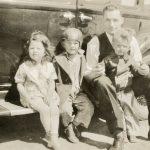

Have you ever thought about capturing your life story for your children, grandchildren and generations beyond to know? Whether documenting it for your family or a wider audience, writing an autobiography is one way to ensure you and your story are remembered.
Below are a few tips I’ve picked up over the years as a Video Biographer that have helped me stay organized when capturing a client’s life story. Perhaps a few will prove helpful as you begin writing your autobiography.
Tips for Writing an Autobiography
Start by organizing the process into three stages: 1) Planning, 2) Content Gathering, and 3) Editing. Below are few tips for each stage.
Planning
- Know your Audience
Are you writing your autobiography for your family and descendants? If so, think about what you would want to know about your own grandparents and ancestors. What stories, information, delivery style, tone and so on would resonate with you? If your audience is the general public or your peers, consider their perspective. - Identify your Goals
What will your autobiography cover? Will you include your entire life story or focus on a specific theme throughout? Will you include family history and life lessons? Write your goals down to help you stay focused during the editing process. - Set a Timeline
Do you have an end date in mind for presenting your autobiography to your family or sending it to a publisher? If so, work backwards from the date and set monthly, weekly and daily writing goals. Include time for breaks as you will discover you will need to be able to step away to maintain perspective. - Create an Outline
An outline will keep you organized, focused and make editing more manageable. Start by identifying general categories (childhood, young adulthood, career, etc.), then add sub-categories and then sub-categories under those. Expect to modify the outline throughout the editing process.
Content Gathering
- Write, Write, Write
It’s time to let your thoughts and stories flow. Be sure to keep a notepad or voice recorder handy since memories surface in their own time. Leave one on your nightstand, in your car, next to the shower, etc. Do not edit at this point. Just write. - What to Include
Wondering what stories and information to include in your autobiography? Check out these two articles: ‘The Stories That Bind Us’ by Bruce Feiler, NYT. and ‘The Power of Myth: The Benefits of Sharing Family Stories of Hard Times’ for guidance. - Memory Triggers
Review old journals or diaries, photo albums, year books and family movies in order to bring back memories. Drive through your old neighborhood. Dig through boxes you may have packed away that hold objects from your past. You’ll be surprised at what you remember. - Visual Elements
 Gather relevant photos, documents, maps and other memorabilia to enhance your stories. Visual elements add dimension and connect your audience with your experience in a way words often struggle to do.
Gather relevant photos, documents, maps and other memorabilia to enhance your stories. Visual elements add dimension and connect your audience with your experience in a way words often struggle to do. - Stay Organized!
As you gather content, be sure to label and file the material under the appropriate section in your outline. Organizing now will help enormously when you are ready to edit.
Editing
- Prioritize
As tempting as it is to include every thought and life experience, your audience will find it overwhelming. Instead, identify the stories that support your goals and then rank each by importance. Not only will your content become more manageable but you will start to see themes and patterns emerge, making you a better storyteller. - Stick to your Timeline
While it’s important to stick to your timeline, it’s equally important to schedule daily and even weekly breaks to clear your head. Writing an autobiography is an enormous project so its key to give yourself time to step away in order to prevent burn out and provide you with a fresh perspective. - Stay Focused
As you write your autobiography, refer back to your outline, goals and audience often. Alternate between working on the details of a story and the broader story as a whole. - Outside Input
It’s never easy to have an outsider critique work you’ve poured your heart into but a fresh pair of eyes can help identify weak spots. Ask a friend, family member or even a stranger their thoughts and what could be improved upon. While you may not agree, it will provide some valuable food for thought.
If you need help writing your autobiography then consider taking a local or online class, working with a writing mentor or hiring a professional biographer.
Writing an autobiography requires a great deal of time and energy. More than most people realize. Perhaps these tips will help make the process a bit more manageable.

~ Legacy Videos ~
Give your family the gift of a lifetime by capturing your life story, family history and memories in a Legacy Video.

Here at Family Tree Video we produce Legacy Videos, modern-day memoirs that weave a filmed interview together with family photos, documents, maps and other memorabilia. The result is a beautiful “moving portrait” capturing you as you share stories and memories from throughout your life – a gift your family will treasure for generations to come.
To learn more about capturing your life story in a Legacy Video, visit us at FamilyTreeVideo.com.
Family Tree Video, LLC
Legacy Video Production
Since 2008
Susan Saunders
(312) 402-6406
Like us on Facebook!
Follow us on Instagram!
Writing an Autobiography
Writing an Autobiography

Legacy Videos
Capturing Life Stories and Family History
for Future Generations

Family Tree Video
Video Biographies ~ Family History Videos ~ Video Memoirs
Anniversary Videos ~ Family Documentaries
Tribute Videos ~ Heirloom Videos
Legacy Video Production
~ Since 2008 ~

